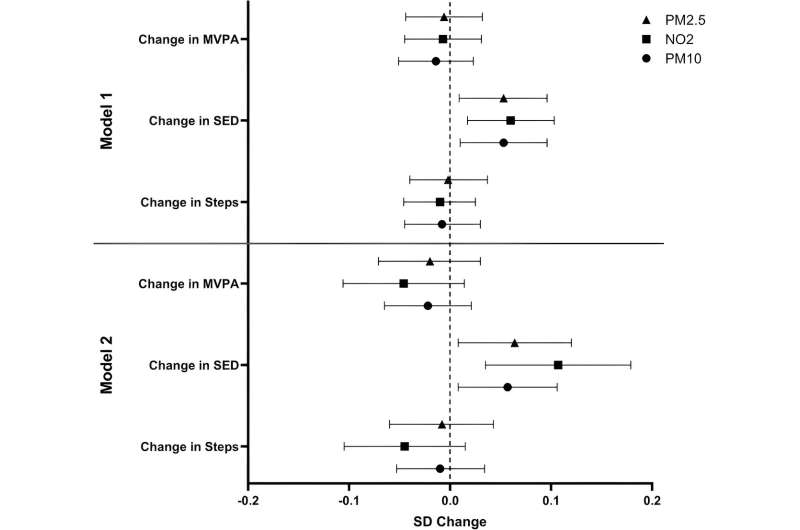This article has been reviewed according to Science X's editorial process and policies. Editors have highlighted the following attributes while ensuring the content's credibility:
fact-checked
peer-reviewed publication
proofread
Exposure to air pollution associated with increase in sedentary time, study finds

Long-term exposure to current levels of UK air pollution has been found to be associated with an annual increase of up to 22 minutes of sedentary time each day, in a study published in the Journal of Public Health.
Researchers based at the National Institute for Health and Care Research (NIHR) Leicester Biomedical Research Centre (BRC) discovered this trend in what is thought to be the first study of its kind to closely examine the relationship between the levels of background pollution people are regularly exposed to in the UK environment and their levels of physical activity and sedentary behavior.
Sedentary behavior is the amount of time spent lying, reclining, sitting, or standing still. Higher levels of sedentary behavior are known to be linked to poorer health, including heart disease, several types of cancer, and earlier death.
Dr. Jonathan Goldney from the University of Leicester explained, "We know that air pollution is associated with cardiometabolic and respiratory diseases, and in 2019, the World Health Organization estimated that 99% of the global population breathe air containing high levels of pollutants."
"Levels of air pollution may affect people's ability to exercise or their enjoyment of exercise. It may also be considered a risk factor for increasing levels of sedentary behavior by encouraging sitting time indoors and discouraging active time outdoors, further increasing the risk of chronic disease in a feedback loop."
In this study, the team, which included the Director of the NIHR Leicester BRC, Professor Melanie Davies CBE, took a close look at observations made on 644 people at risk of type 2 diabetes taking part in the 'Walking Away from type 2 diabetes' behavioral intervention, which aimed to increase physical activity through walking.
Dr. Goldney added, "The participants in the study wore accelerometers around their waists for seven consecutive days during waking hours. This gave us their daily minutes of moderate-to-vigorous physical activity and sedentary time on three occasions over a three-year period—and an incredible opportunity to look for any long-term trends."
Annual average levels of the most measured air pollutants in health research (long-term particulate matter with a diameter of less than or equal to 2.5 μm (micrometers), less than or equal to 10 μm, and nitrogen dioxide) from the year the participant entered the study and the preceding two years (sourced from the Department for Environment Food and Rural Affairs' Pollution Climate Mapping model) were then compared to the annual change in accelerometer-measured sedentary time.
After taking into account important factors like social deprivation and measures of the built environment, the associations between long-term particulate matter with diameter less than or equal to 2.5 μm (micrometers), 10 μm, and nitrogen dioxide and annual change in accelerometer measured sedentary time and physical activity were examined.
Dr. Goldney said, "Although the levels of pollutants we measured were not associated with a change in moderate-to-vigorous physical activity or number of steps taken, we found that they were associated with an annual increase in sedentary time."
"An increase of 1 μgm−3 in the average concentration of atmospheric nitrogen dioxide was associated with an increase in sedentary time of 1.52 minutes per day per year in the most conservative model. And across the group, our findings suggest that high levels of exposure to nitrogen dioxide were associated with up to 22 minutes per day of increased sedentary time per year."
"We observed this association regardless of how concentrations of pollutants were measured, including as a three-year average (year of start of observation with the two preceding years), or as the average pollutant concentration during the 12-month observation period."
"If levels of air pollution are causing this increase in sedentary time, interventions to reduce ambient air pollution concentration such as low emissions zones could have a really positive impact on individual's levels of sedentary behavior, and a significant effect on public health," Dr. Goldney concluded.
More information: Jonathan Goldney et al, Long-term ambient air pollution exposure and prospective change in sedentary behaviour and physical activity in individuals at risk of type 2 diabetes in the UK, Journal of Public Health (2023). DOI: 10.1093/pubmed/fdad263




















